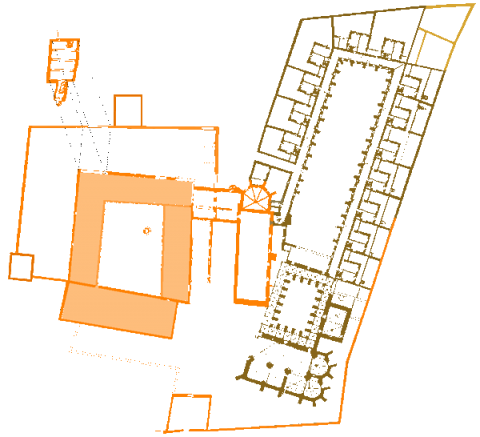After his election as pope in 1352, Innocent VI decided to build a Carthusian monastery next to his palace. He wanted to express his loyalty, friendship and gratitude to Jean Birelle, general of the Carthusian order, and his determination to return to rigor and discipline after the pomp and circumstance which marked the previous papacy of Pope Clement VI. The papal bull which founded La Chartreuse, in 1356, entailed the creation of a community which included twelve religious, one prior, fourteen lay brothers, two nurses, two clerks and nine domestics, and provided sufficient funds for the community. It took a few years to build the monastery, which included a large cloister which was also a cemetery (the monks were buried here up until the French Revolution) surrounded on three sides by 13 houses for the monks, a small cloister known as the “cloître du colloque” which held the chapter room, and a church, sacristy and bell tower, which have since vanished. This ensemble was built to the east of the palace and the consistory. The church was consecrated in 1358. Domestic quarters such as a laundry, called the bugade, and the bakery, were added later. High walls surrounded the entire ensemble. All the work was financed from the pope’s personal finances. In 1360, thinking ahead to his death, Pope Innocent VI had a chapel built to the south of the church, to hold his tomb.
On August 12th 1362, the pope issued several papal bullae granting privileges to La Chartreuse. He exonerated it from duties, taxations and subsidies normally payable to the Pontifical Court, and from payment of the tithe on all its present and future possessions. That same year, the King of France Jean-le-Bon also exonerated La Chartreuse from all taxes on wheat, wine and other goods. His successors did the same, confirming and extending the monastery’s privileges. From King Charles V, in 1380 to Louis XV in 1724, all the French Kings manifested royal generosity, most often when actually visiting Villeneuve-lès-Avignon.
Pope Innocent VI died on September 12th 1362. He had expressed his wish to be buried in the church in La Chartreuse. Architect Bertrand Nogayrol, sculptors Thomas de Tournon and Barthélémy Cavalier created his tomb, installed in the Holy Trinity chapel. The pope’s body was placed in Notre Dame des Doms church for a short while and then went to its final resting place on November 22nd 1362, in the presence of the King of France. In 1789 the tomb was listed among the goods in Villeneuve that deserved to be protected as per the new laws of Year III that covered historical and artistic objects. It became the property of the French government and remained in its original chapel, which had been sold at one point to a farmer who unfortunately stored his farm implements here which badly damaged the chapel. This is how the French inspector of historical monuments, Prosper Mérimée, rediscovered the tomb on September 11th 1834. He had the tomb removed and sheltered in the chapel at the town Hospice, and in 1959 Innocent VI once again returned to the peace and quiet of his chapel in the church in the Chartreuse monastery.



